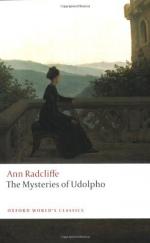|
This section contains 3,974 words (approx. 14 pages at 300 words per page) |

|
SOURCE: “Radcliffe's Dual Modes of Vision,” in Fetter'd or Free? British Women Novelists, 1670-1815, edited by Mary Anne Schofield and Cecilia Macheski, Ohio University Press, 1986, pp. 124-33.
In the following essay, Flaxman declares that critics need to recognize Radcliffe's work as innovative for its time, emphasizing the author's descriptive skills and highlighting her particular techniques in painting a scene.
The new scholarship on women has extended our sense of the novel tradition by bringing hitherto neglected works by women to the attention of critics. Although Ann Radcliffe's work has never been completely neglected, reassessment reveals her importance as a formal innovator in the history of the English novel. Often she is praised for her attention to setting and story and for softening and romanticizing the conventional Gothic novel's atmosphere from horrific effects to merely terrifying ones. But she has never been recognized sufficiently for establishing a new descriptive...
|
This section contains 3,974 words (approx. 14 pages at 300 words per page) |

|


